Roadside Edge Computing Research: how edge computing enables intelligent connected vehicles?
Policies and standards for roadside edge computing are implementing one after another, favoring the boom of the industry.
In April 2020, the National Development and Reform Commission defined the scope of "new infrastructures" for the first time, which includes new infrastructures such as cloud computing and intelligent computing centers; in February 2021, the Ministry of Transport of China issued the "National Comprehensive Three-dimensional Transportation Network Planning Outline", suggesting promoting the digitization and connection of transportation infrastructures, deploying traffic perception systems in an all-round way, and facilitating the application of autonomous driving and vehicle-infrastructure cooperation.
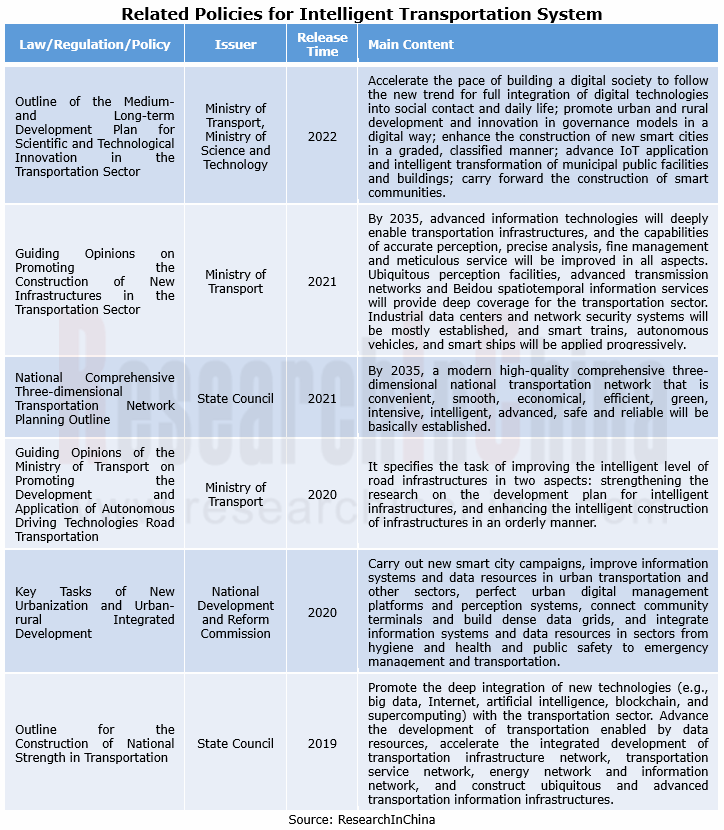
These policies facilitate the steady development of intelligent transportation industry, and help it transition from the information phase to the connection phase, and finally to the intelligent road phase. The powerful roadside perception, edge computing, network communication, and cloud control technologies provide support for efficient fully automated driving.
In addition to benign policies, the standards concerning roadside edge computing get improved:
 In December 2021, the exposure draft of the group standard "Edge Computing Gateway Communication Interface Standard of Intelligent Road" was released. It specifies the communication interface requirements for the southbound heterogeneous device access and the northbound unified access platform of the intelligent road edge computing gateway.
In December 2021, the exposure draft of the group standard "Edge Computing Gateway Communication Interface Standard of Intelligent Road" was released. It specifies the communication interface requirements for the southbound heterogeneous device access and the northbound unified access platform of the intelligent road edge computing gateway.
 In March 2022, the group standard "General Specification for Traffic Information Holographic Acquisition System of Road Intersection" jointly prepared by Huawei, Beijing MapABC Technology, Beijing Chinasoft Zhengtong Information Technology, Shenzhen Traffic Police Bureau, and Changzhou Traffic Police Division took into effect. This standard indicates that edge computing units should be uniformly deployed at intersections; the videos, images and structured data collected in all directions should be managed and calculated to offer the fusion information of intersections which will be uploaded to the business application platform.
In March 2022, the group standard "General Specification for Traffic Information Holographic Acquisition System of Road Intersection" jointly prepared by Huawei, Beijing MapABC Technology, Beijing Chinasoft Zhengtong Information Technology, Shenzhen Traffic Police Bureau, and Changzhou Traffic Police Division took into effect. This standard indicates that edge computing units should be uniformly deployed at intersections; the videos, images and structured data collected in all directions should be managed and calculated to offer the fusion information of intersections which will be uploaded to the business application platform.
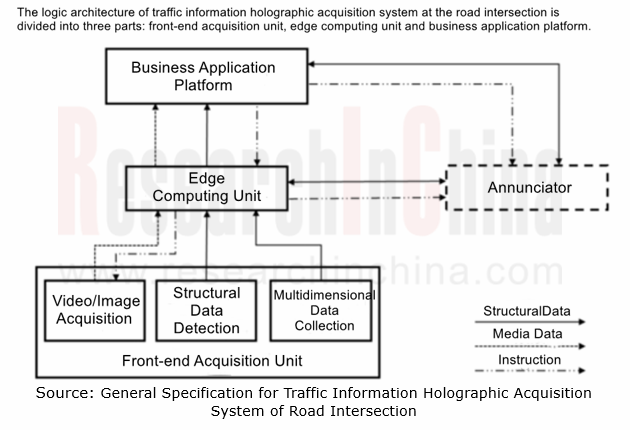
Based on the construction of standardized edge cloud, the standardized cooperation between the urban center cloud and the edge cloud will make a further improvement in the future, in a bid to realize the intercommunication and interconnection between edge cloud devices, and facilitate the unified management on large scale and the application of "terminal-edge-cloud" cooperation.
In the new technology architecture for intelligent roads, "edge computing" is being applied to more scenarios.
Intelligent transportation is transforming from informatization to intelligent connection. The construction of intelligent roads serves as an important part in intelligent transportation. At present, in China more than 20 provinces have completed the renovation and construction of over 40 intelligent highways, and "cloud-network-edge-terminal" is becoming a new-generation technology architecture for intelligent roads. In this new technology architecture, the "edge" is playing a more prominent role and making its way into more application scenarios.
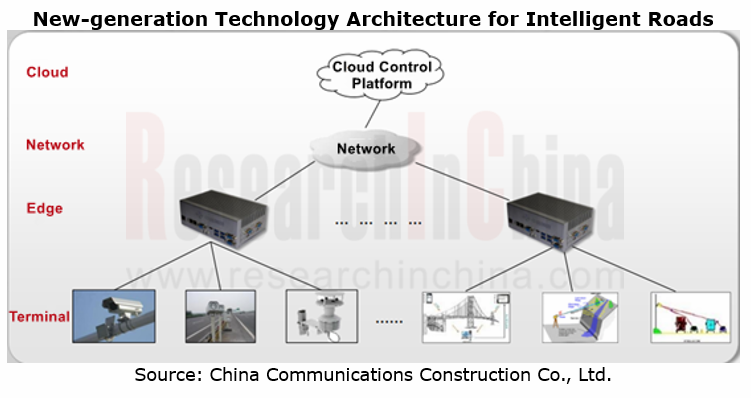
Edge devices with certain computing power can ease the pressure of cloud computing at the roadside. In addition, edge computing can cut the transmission time of data in the network, simplify the network structure, and also enables precise perception of traffic conditions. Edge computing thus has a decided advantage in construction of intelligent roads, especially in the telematics environment.
(1) Application of edge computing in vehicle-infrastructure cooperation
Through the lens of the three delivery modes of edge computing, 5G multi-access edge computing (MEC) best fits the intelligent transportation sector. As MEC is introduced into vehicle-infrastructure cooperation, edge computing devices allows direct, real-time reception of localized data from in-vehicle terminals and roadside sensors, analyze the data, and transmit the analysis results to other connected vehicles in the adjacent area with an ultralow latency. The whole process can be completed in milliseconds.
The new-generation vehicle-infrastructure cooperation technology architecture enables fusion application of MEC, C-V2X, 5G and more, delivering far stronger end-to-end communication capabilities. This architecture is also a solution to the problem of high construction complexity and costs posed by wired backhaul of the roadside data. Moreover, when the penetration rate of V2X equipment is not high enough, it provides N2V services for ordinary vehicles without OBU installed via the 4G/5G network, revving up the application and promotion of vehicle-infrastructure cooperation.
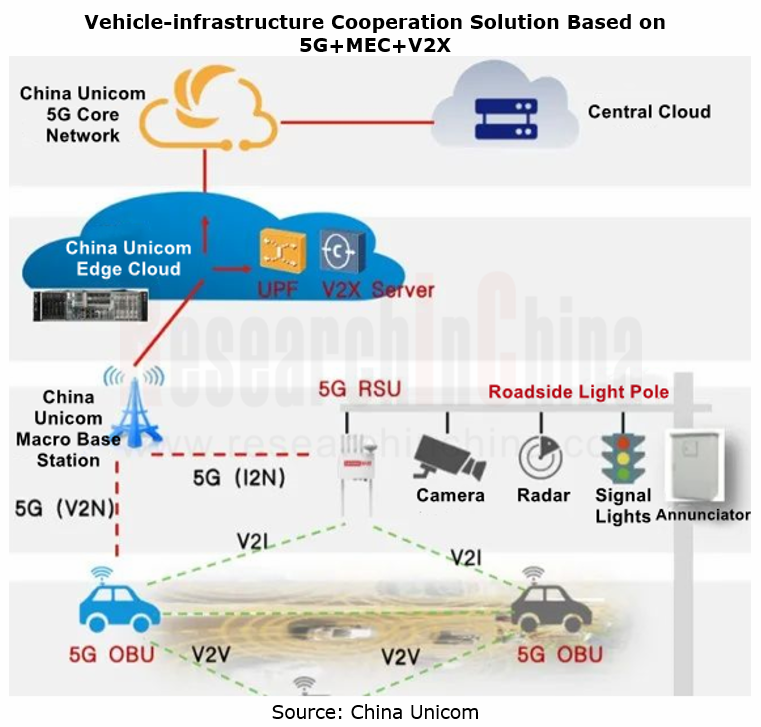
(2) Application of edge computing in HD map
The use of HD maps helps to achieve the application of L4/L5 autonomous driving, but still faces some challenges such as real-time dynamic updates. The introduction of MEC is a better way to solve these problems.
The MEC carrying HD maps enables rapid distribution of dynamic maps. Combined with 5G network slicing technology, it allows a vehicle to acquire HD map data in real time and save much storage space of the head unit.
(3) Application of edge computing in smart park
The introduction of edge computing into a smart park not only enables perception, monitoring, analysis, control, and integration of the resources at all key links of the park, but also realizes vehicle-infrastructure cooperation there.
Shougang Winter Olympics Park has built a 5G+C-V2X based cooperative vehicle-infrastructure system (CVIS) that enables global traffic situational awareness. The facility deploys sensing devices like cameras and radars, and connects intelligent devices such as signal lights on both sides of the trunk road and key intersections in the park, in a bid to achieve global traffic information collection. It also deploys perception-based multi-source heterogeneous fusion perception algorithms inside the roadside MEC, develops and optimizes algorithms for Winter Olympics scenarios, which enable traffic video detection and tracking in weather conditions, e.g., heavy snow and fog.
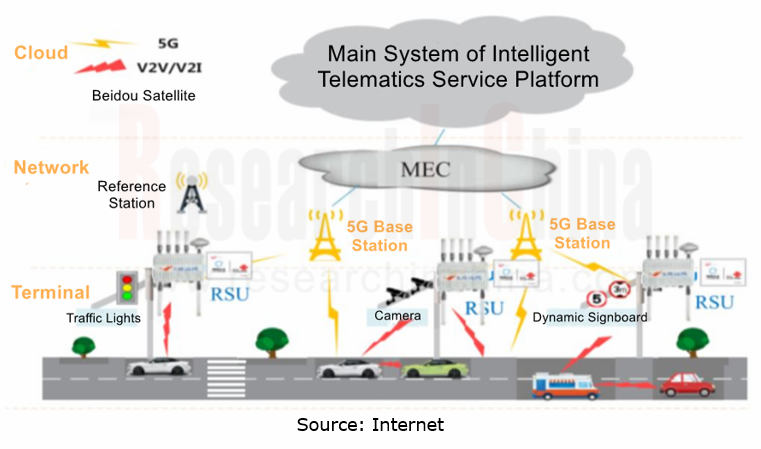
(4) Application of edge computing in highway scenario
At the highway entrance ramp, traffic accidents are prone to happen when vehicles merge. Intelligent perception devices deployed at the ramp such as cameras and radars acquire vehicle movement trajectories and traffic flow data, then the deployed MEC devices are used for perception fusion and vehicle trajectory prediction, and eventually, the prediction results are distributed to the connected vehicles, through which capabilities including collision warning and ramp control in the merging area, lane change assistance, and vehicle speed guidance are enabled.
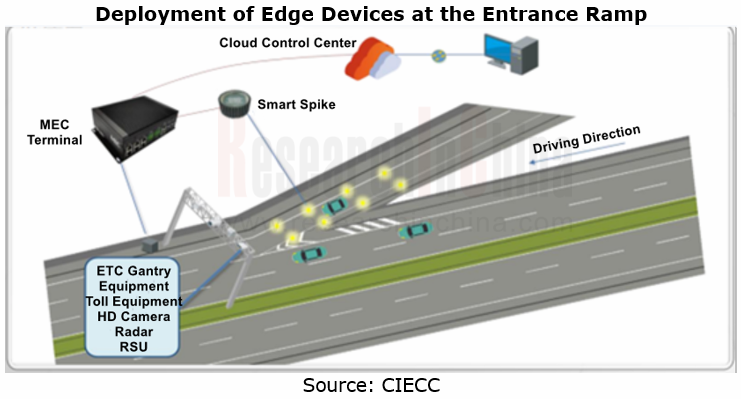
The tremendous derived value of the industry brings about competition for layout among companies.
The large-scale construction of intelligent roads is accompanied by increasing companies deploying edge computing. Players of chips, computing platforms, software, communication and cloud services among other fields are working to explore the roadside edge computing market. Among them, cloud service providers with their superiorities in cloud computing technology tend to apply the cloud computing technology to the edge side. For example, Chinese giants such as BAT (Baidu, Alibaba and Tencent) have begun to sink their computing capabilities into the edge side since 2018, racing to roll out their edge computing products.
In terms of product layout, the three major operators (China Mobile, China Telecom and China Telecom) have made comprehensive deployments in edge computing, cloud control platform, and communication technology to connect the edge computing-network communication-cloud control links; in addition to edge computing units, Internet companies like Huawei, Alibaba, and Tencent, as well as some conventional roadside equipment suppliers also deploy roadside perception units to build a complete roadside perception-computing system solution.
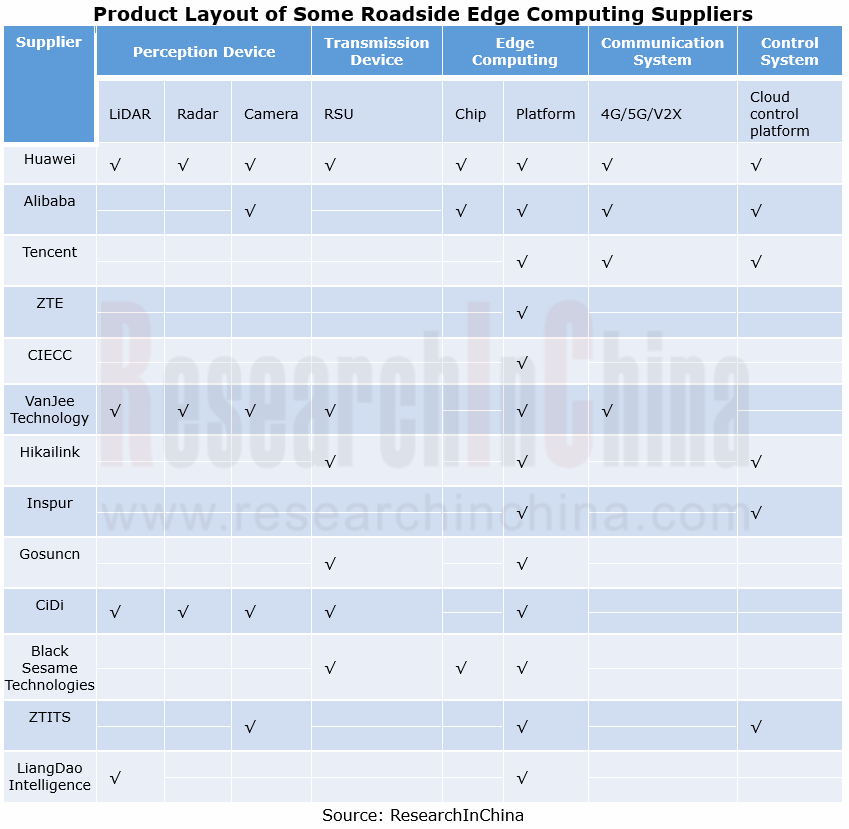
Huawei: the roadside perception units and ITS800 edge computing nodes used in the holographic intersection solution are all independently developed by Huawei.
At present, Huawei has built a complete intelligent road industry chain ecosystem, with R&D and production capabilities covering the whole chain from chip, edge computing and roadside perception to cloud platform. The Kunpeng + openEuler software-hardware cooperative edge computing platform uses Huawei's self-developed processor Kunpeng 920, TaiShan200 edge server (model: 2280E) and openEuler server operating system.
Huawei's edge computing unit features iteration and upgrade of algorithm cloud edge, real-time analysis and generation of structural data of road conditions, and access to V2X real-time service data.
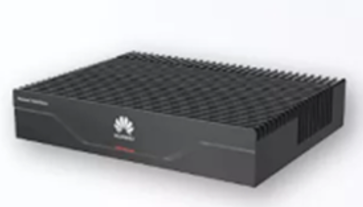
Alibaba Cloud: in 2021 it introduced a new "Cloud-Edge Integrated Small Station" where Neuro edge computing terminal, edge computing server, traffic big data all-in-one, and intelligent vehicle screen for vehicle-infrastructure cooperation help to reduce much of the cost of intelligent road projects and increase the return on investment. Among them, the Neuro edge computing terminal with small size boasts multiple capabilities and also supports cloud management.
Alibaba Cloud has deployed Neuro edge computing terminals on the Chengdu Second Ring Road Expressway and Chengdu-Yibin Expressway. The way to deploy a pole every 800 meters needs fewer devices arranged and saves the construction cost as much as possible.
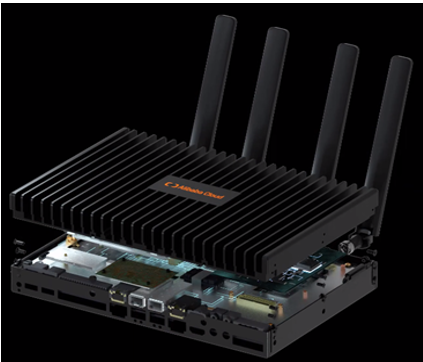
In addition, chip and computing platform providers have also launched roadside-related edge computing products.
Black Sesame Technologies: the company has unveiled FAD Edge, a roadside perception computing platform for vehicle-infrastructure cooperation scenarios. Based on Huashan No.2 A1000 autonomous driving chip (later to be upgraded to A1000 Pro), FAD Edge applies cloud computing to the edge side, and completes most of computing tasks at the edge computing nodes to meet the ultralow latency needs of vehicle-infrastructure cooperation; in addition, with 58 to 224TOPS computing power, FAD Edge supports multi-channel perception data access and multiple types of sensors; the built-in multi-channel perception device data fusion algorithms can be connected with the V2X system.
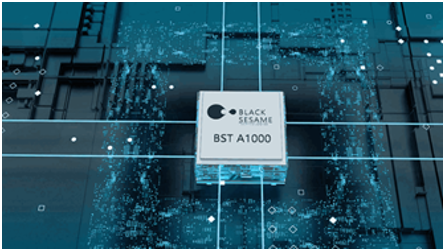
Unlimited AI: the company launched a super roadside fusion domain controller in 2021. As the world's first MEC and RSU integrated design, this product has strong real-time computing power, and is easy to deploy and maintain. With no need to occupy ground and municipal space separately, it reduces 75% engineering construction cost and 80% maintenance fees, remaining outstanding in mass adoption.
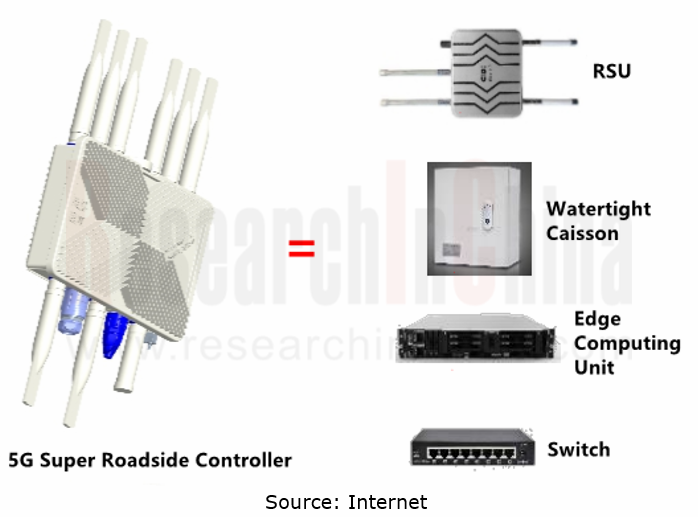
China Roadside Edge Computing Industry Report, 2022 highlights the following:
 Research on status quo of smart city and intelligent transportation industry, main intelligent transportation solutions, etc.;
Research on status quo of smart city and intelligent transportation industry, main intelligent transportation solutions, etc.;
 Research on edge computing (overview), computing modes, status quo of roadside edge computing standards, market size, status quo of industry chain, necessity of roadside application, etc.;
Research on edge computing (overview), computing modes, status quo of roadside edge computing standards, market size, status quo of industry chain, necessity of roadside application, etc.;
 Research on the connection of roadside edge computing with network communication, the connection with cloud control, etc.;
Research on the connection of roadside edge computing with network communication, the connection with cloud control, etc.;
 Research on the main application directions of roadside edge computing (including intelligent highway, smart intersection, smart park, and parking lot), etc.;
Research on the main application directions of roadside edge computing (including intelligent highway, smart intersection, smart park, and parking lot), etc.;
 Research on main roadside edge computing devices and solution providers (main roadside computing devices, overall roadside computing solutions and application, etc.).
Research on main roadside edge computing devices and solution providers (main roadside computing devices, overall roadside computing solutions and application, etc.).
New Energy Vehicle Cross-Domain (Electric Drive System and Powertrain Domain) Integration Trend Report 2025-2026
Electric Drive and Powertrain Domain Research: New technologies such as three-motor four-wheel drive, drive-brake integration, and corner modules are being rapidly installed in vehicles.
Electric dri...
Analysis on Desay SV and Joyson Electronic's Electrification, Connectivity, Intelligence and Sharing, 2025
Research on Desay SV and Joyson Electronic: Who is the No.1 Intelligent Supplier?
Both Desay SV and Joyson Electronic are leading domestic suppliers in automotive intelligence. "Analysis on Desay SV ...
OEMs and Tier 1 Suppliers' Cost Reduction and Efficiency Enhancement Strategy Analysis Report, 2025
ResearchInChina released the "OEMs and Tier 1 Suppliers' Cost Reduction and Efficiency Enhancement Strategy Analysis Report, 2025", summarizing hundreds of cost reduction strategies to provide referen...
Automotive Fixed Panoramic Sunroof and Smart Roof Research Report, 2025
With the intelligent application of car roofs as the core, this report systematically sorts out a series of new products such as fixed panoramic sunroof/openable sunroof, ceiling screen, roof ambient ...
Automotive-Grade Power Semiconductor and Module (SiC, GaN) Industry Research Report, 2025
SiC/GaN Research: Sales volume of 800V+ architecture-based vehicles will increase more than 10 times, and hybrid carbon (SiC+IGBT) power modules are rapidly being deployed in vehicles.
Sales volume o...
Cockpit Agent Engineering Research Report, 2025
Cockpit Agent Engineering Research: Breakthrough from Digital AI to Physical AI
Cockpit Agent Engineering Research Report, 2025 starts with the status quo of cockpit agents, summarizes the technical ...
Prospective Study on L3 Intelligent Driving Technology of OEMs and Tier 1 Suppliers, 2025
L3 Research: The Window of Opportunity Has Arrived - Eight Trends in L3 Layout of OEMs and Tier 1 Suppliers
Through in-depth research on 15 OEMs (including 8 Chinese and 7 foreign OEMs) and 9 Tier 1 ...
China Commercial Vehicle IoV and Intelligent Cockpit Industry Research Report 2025
Commercial Vehicle IoV and Cockpit Research: The Third Wave of Passenger Car/Commercial Vehicle Technology Integration Arrives, and T-Box Integrates e-Call and 15.6-inch for Vehicles
I. The third wav...
Intelligent Vehicle Electronic and Electrical Architecture (EEA) and Technology Supply Chain Construction Strategy Research Report, 2025
E/E Architecture Research: 24 OEMs Deploy Innovative Products from Platform Architectures to Technical Selling Points
According to statistics from ResearchInChina, 802,000 passenger cars with domain...
Research Report on Intelligent Vehicle Cross-Domain Integration Strategies and Innovative Function Scenarios, 2025
Cross-Domain Integration Strategy Research: Automakers' Competition Extends to Cross-Domain Innovative Function Scenarios such as Cockpit-Driving, Powertrain, and Chassis
Cross-domain integration of ...
China Autonomous Driving Data Closed Loop Research Report, 2025
Data Closed-Loop Research: Synthetic Data Accounts for Over 50%, Full-process Automated Toolchain Gradually Implemented
Key Points:From 2023 to 2025, the proportion of synthetic data increased from 2...
Automotive Glass and Smart Glass Research Report, 2025
Automotive Glass Report: Dimmable Glass Offers Active Mode, Penetration Rate Expected to Reach 10% by 2030
ResearchInChina releases the Automotive Glass and Smart Glass Research Report, 2025. This r...
Passenger Car Brake-by-Wire (BBW) Research Report, 2025
Brake-by-Wire: EHB to Be Installed in 12 Million Vehicles in 2025
1. EHB Have Been Installed in over 10 Million Vehicles, A Figure to Hit 12 Million in 2025.
In 2024, the brake-by-wire, Electro-Hydr...
Autonomous Driving Domain Controller and Central Computing Unit (CCU) Industry Report, 2025
Research on Autonomous Driving Domain Controllers: Monthly Penetration Rate Exceeded 30% for the First Time, and 700T+ Ultrahigh-compute Domain Controller Products Are Rapidly Installed in Vehicles
L...
China Automotive Lighting and Ambient Lighting System Research Report, 2025
Automotive Lighting System Research: In 2025H1, Autonomous Driving System (ADS) Marker Lamps Saw an 11-Fold Year-on-Year Growth and the Installation Rate of Automotive LED Lighting Approached 90...
Ecological Domain and Automotive Hardware Expansion Research Report, 2025
ResearchInChina has released the Ecological Domain and Automotive Hardware Expansion Research Report, 2025, which delves into the application of various automotive extended hardware, supplier ecologic...
Automotive Seating Innovation Technology Trend Research Report, 2025
Automotive Seating Research: With Popularization of Comfort Functions, How to Properly "Stack Functions" for Seating?
This report studies the status quo of seating technologies and functions in aspe...
Research Report on Chinese Suppliers’ Overseas Layout of Intelligent Driving, 2025
Research on Overseas Layout of Intelligent Driving: There Are Multiple Challenges in Overseas Layout, and Light-Asset Cooperation with Foreign Suppliers Emerges as the Optimal Solution at Present
20...